These car manufacturers are making the most progress in cutting carbon emissions

24K-Production // Shutterstock
These car manufacturers are making the most progress in cutting carbon emissions
A charging vehicle with a sunset in the background.
The transportation industry, a longtime and significant contributor to CO2 emissions, has reached a major milestone: In 2023, carbon emissions on new cars hit a record low of 319 grams of CO2 per mile on average.
This decline is a testament to the decades-long regulatory and corporate efforts to make the automobile industry more environmentally friendly—and there are more reductions coming. While record-low emissions are a reason to celebrate, carmakers still have a long way to go to meet the ambitious new emission targets laid out by the Biden administration in March 2024. By 2027, CO2 emissions must drop about 50% to 170 grams of CO2 per mile on average.
CO2 emissions from vehicles have led to the concentration of greenhouse gases in the atmosphere, trapping heat and raising temperatures worldwide. This phenomenon is known as global warming, and its long-term impact is well-documented. Global warming contributes to more droughts, warmer temperatures, biodiversity loss, poverty, and health risks.
However, today’s new cars are increasingly cleaner and more efficient than ever, according to the 2023 Automotive Trends Report by the Environmental Protection Agency. Since 2004, innovations combined with market trends have led to an incremental improvement each year in CO2 emissions and record-fuel economy, lowering carbon emissions.
The CO2 emissions of the four most significant types of vehicles had reached a record low. However, the long-term shift in the market toward sport utility vehicles partially negated some of the overall emission reductions. According to the EPA, 1 kilogram of CO2 a vehicle releases equals 1.1 pounds of coal burned.
Though rates vary across the globe, manufacturers are stepping up their focus on limiting emissions. Nine of the 14 largest U.S. car manufacturers have experienced a fall in their real-world emissions rates since 2018, with German manufacturers leading the way. Four—Honda, GM, Mazda, and Subaru—have seen increased emissions.
Historically, the automobile industry has been a major polluter and contributor to global greenhouse gas emissions. Vehicles powered by fossil fuels released large amounts of carbon dioxide and other pollutants before the government enforced fuel efficiency rules in the 1970s. Over the last four decades, the development of hybrid and electric cars, stringent emission standards, and plans to phase out gas-powered vehicles have all contributed to mitigating the environmental effects of these emissions.
New rules from federal agencies like the EPA, the National Highway Traffic Safety Administration, and the California Air Resources Board have contributed to curbing vehicular emissions and improving fuel economy. Evolving regulations also help improve environment-friendliness in the automobile industry by pushing carmakers to self-regulate in anticipation of future regulations.
Private actors have also stepped up in the fight to make the automobile industry more eco-friendly. Despite its hesitant approach to the electric vehicle market, Toyota pledged in December 2023 that by 2026, over 20% of all its vehicle sales in Europe would be zero-emission models. Kia and Hyundai announced in June 2023 that they would establish a Supplier CO2 Emission Monitoring System to track emissions across the supply chain.
The General examined Environmental Protection Agency data to see which major car manufacturers made the most progress in reducing CO2 emissions in 2023 and how their output changed over time. The data for 2023 is preliminary and comes from 13 major manufacturers in the U.S. Carmakers are ranked by the overall reduction in emissions.
![]()
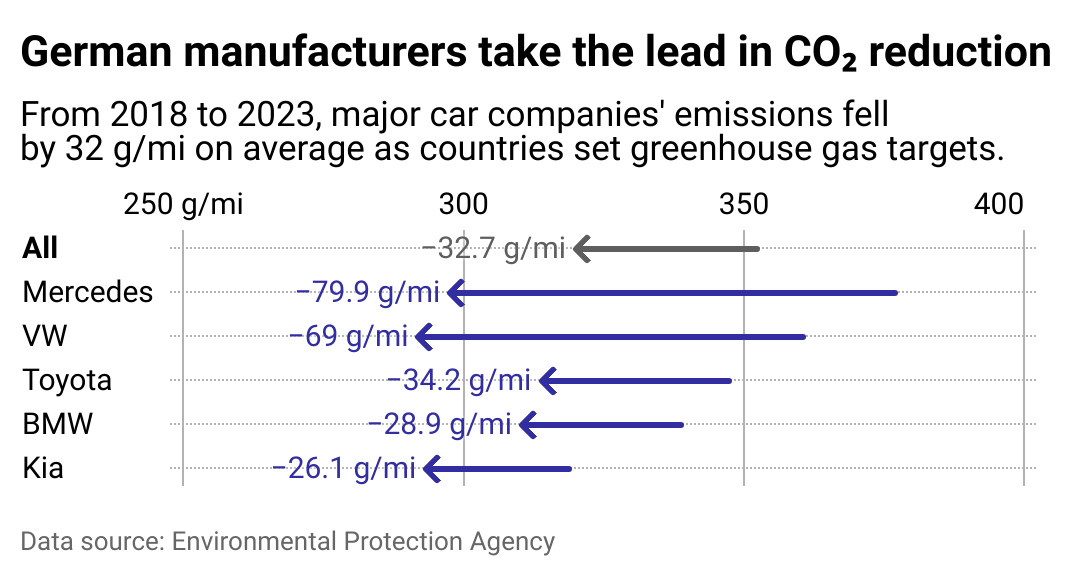
The General
How federal emissions targets play a role
A line chart with EPA data showing how German manufacturers take the lead in CO2 reduction. From 2018 to 2023, major car companies’ emissions fell by 32 grams per mile on average as countries set greenhouse gas targets.
Since the first greenhouse gas standards were adopted in 2010, policies have come a long way toward curbing emissions. According to the Center for Climate and Energy Solutions, the EPA’s rule for passenger cars and light trucks through 2026 is projected to reduce carbon dioxide emissions by 3.1 billion tons by 2050. Furthermore, with the NHTSA’s current standards, the center noted that fleetwide fuel efficiency is expected to reach 49 mpg by 2026, reducing gasoline use and benefiting the environment and public health simultaneously.
As the U.S. works toward these lofty targets, it can look to Germany as an exemplar for meeting ambitious climate targets. German carmakers outpace their non-German counterparts in emission reductions, and the nation’s climate policies include a 2030 target to reduce greenhouse gasses by 65% compared to 1990 levels and a 2040 target to reduce emissions by at least 88% of 1990 levels. By 2050, Germany seeks to have a negative emission balance—meaning it emits less emissions than is removed.
Legislation plays a key role in spurring climate-friendly innovation.

Josh Lefkowitz // Getty Images
#9. Hyundai
Genesis electric cars made by Hyundai in a showroom.
– Average carbon emissions (2023 models): 299.6 grams per mile
– Five-year change: -11.6 grams per mile (-9.3% decline)
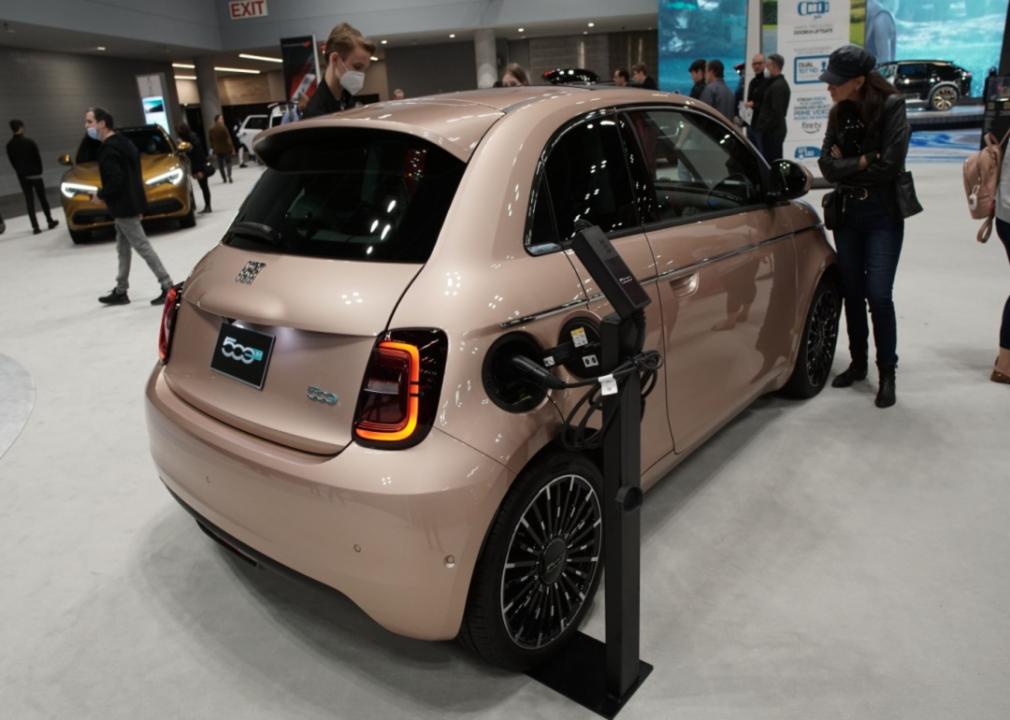
quiggyt4 // Shutterstock
#8. Stellantis
A tan electric Fiat at a car show.
– Average carbon emissions (2023 models): 397 grams per mile
– Five-year change: -12.2 grams per mile (-3.7% decline)
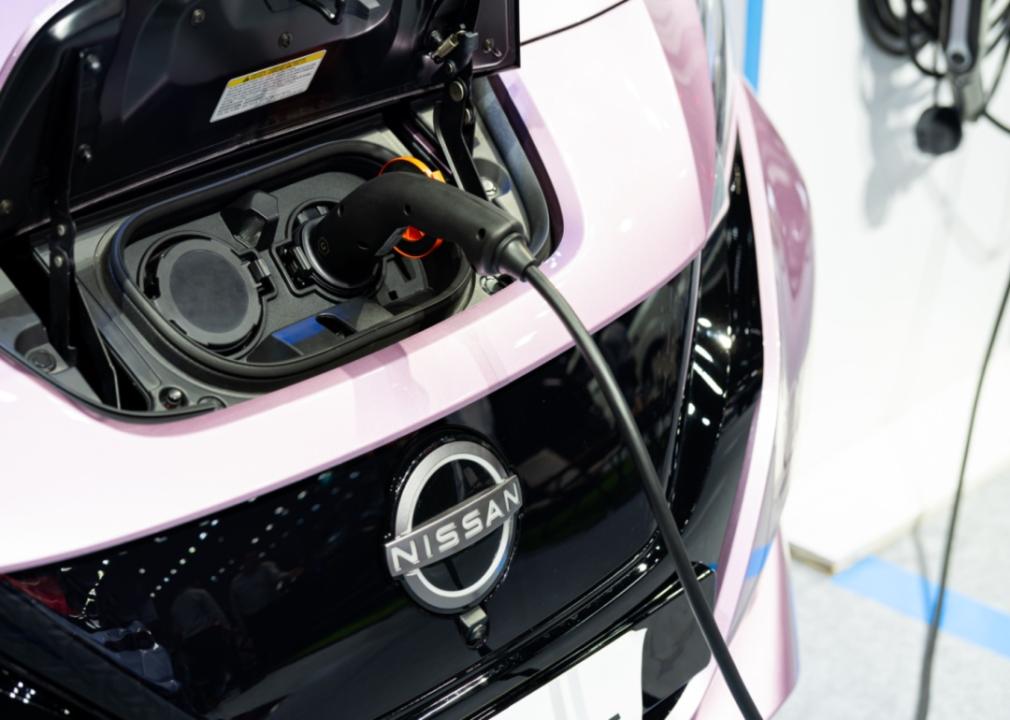
Wongsakorn Napaeng // Shutterstock
#7. Nissan
Close up of a pink Nissan electric vehicle charging.
– Average carbon emissions (2023 models): 314.2 grams per mile
– Five-year change: -12.6 grams per mile (-3% decline)
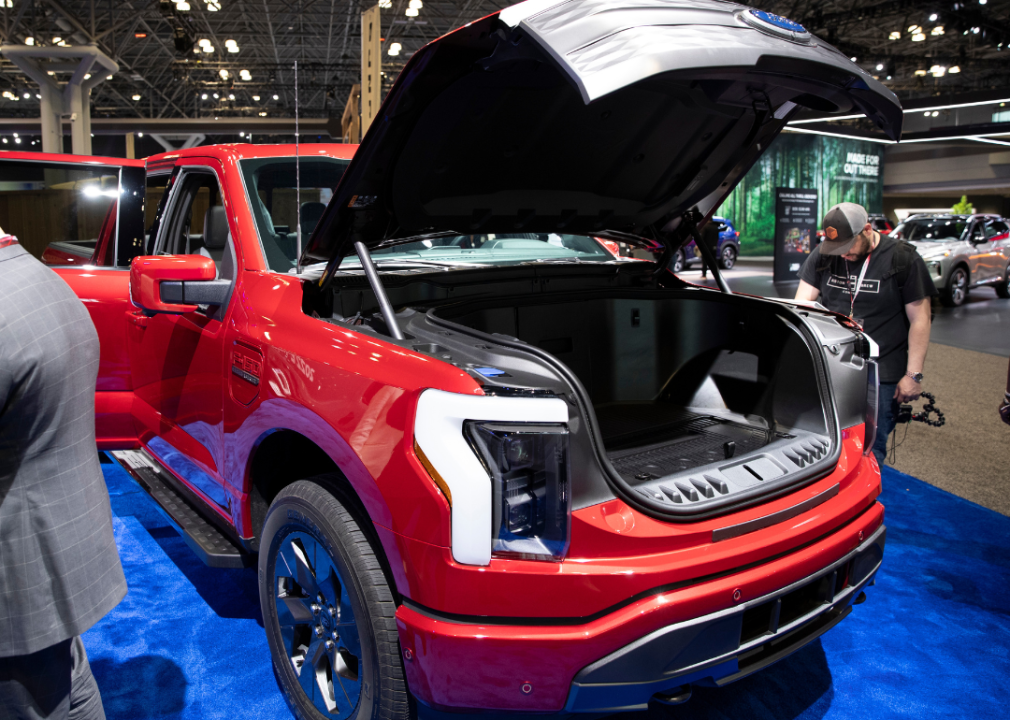
Liao Pan/China News Service // Getty Images
#6. Ford
A red Ford truck EV in a showroom with the hood open.
– Average carbon emissions (2023 models): 376.4 grams per mile
– Five-year change: -20.1 grams per mile (-3.8% decline)
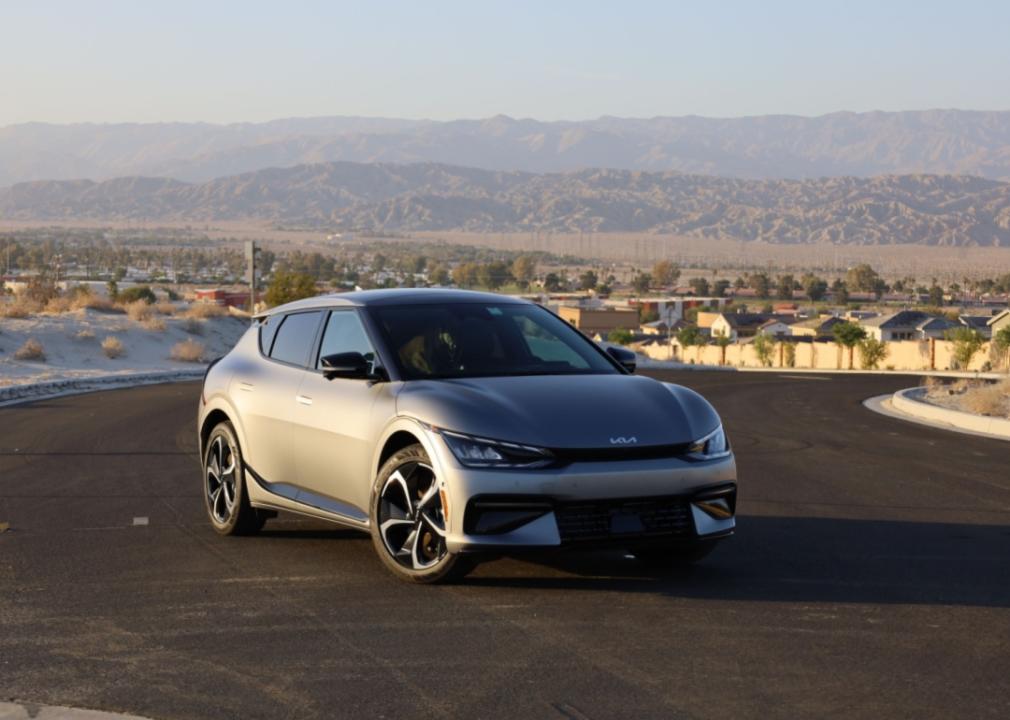
Luxury Fred Sherman // Shutterstock
#5. Kia
A silver Kia electric vehicle in a neighborhood with a desert and mountains in the background.
– Average carbon emissions (2023 models): 293.3 grams per mile
– Five-year change: -26.1 grams per mile (-5.1% decline)

kittyfly // Shutterstock
#4. BMW
The interior of a BMW electric vehicle.
– Average carbon emissions (2023 models): 310.4 grams per mile
– Five-year change: -28.9 grams per mile (-8.2% decline)
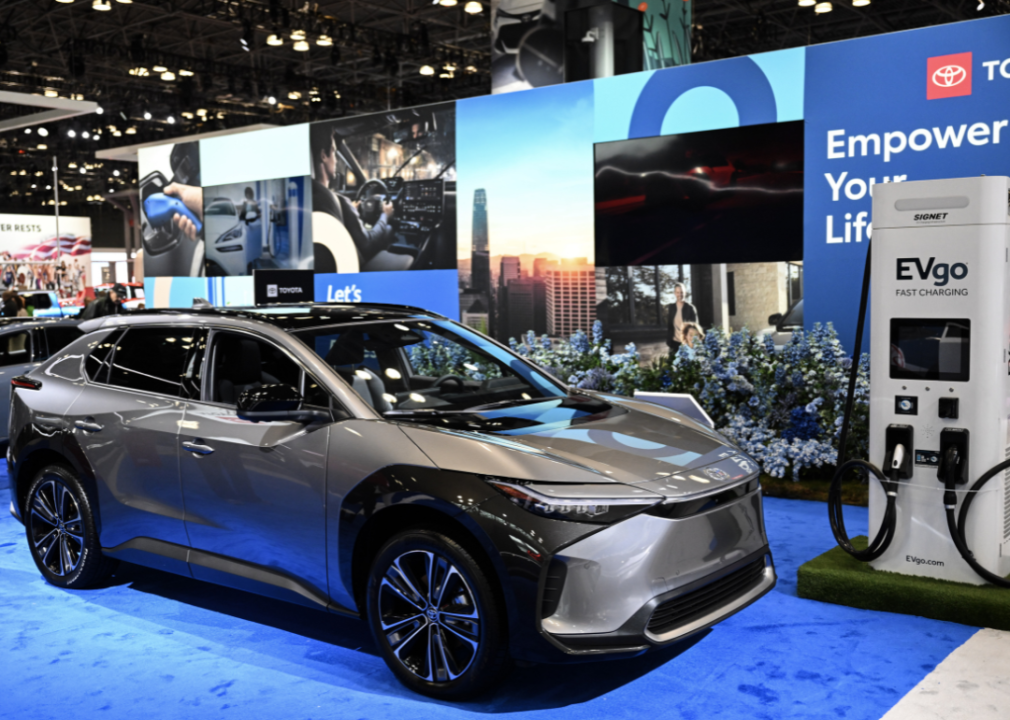
Fatih Aktas/Anadolu // Getty Images
#3. Toyota
A silver Toyota SUV electric vehicle in a showroom.
– Average carbon emissions (2023 models): 313.8 grams per mile
– Five-year change: -34.2 grams per mile (-8.5% decline)

balipadma // Shutterstock
#2. VW
A charging VW electric vehicle outside.
– Average carbon emissions (2023 models): 291.9 grams per mile
– Five-year change: -69 grams per mile (-9.8% decline)

Deb Cohn-Orbach/UCG/Universal Images Group // Getty Images
#1. Mercedes
Electric vehicle sign at a Mercedes dealership in Manhattan.
– Average carbon emissions (2023 models): 297.6 grams per mile
– Five-year change: -79.9 grams per mile (-19.1% decline)
This story originally appeared on The General and was produced and
distributed in partnership with Stacker Studio.